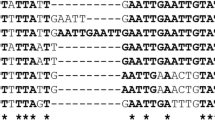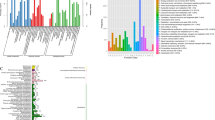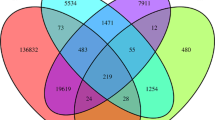Abstract
Simple sequence repeat (SSR) markers are highly informative and widely used in genetic studies and plant breeding. Sporobolus virginicus is a halophytic turf grass that shows a high tolerance to salinity of up to 1.5 M NaCl. In the present study, we developed 148,411 SSR markers on 48,512 transcriptome contigs derived from RNA sequencing data. Of 33 randomly selected SSR markers, 23 (69.7%) produced clean amplification products, and an average of 1.25 alleles per marker was detected in S. virginicus genotypes. These markers were also examined by detecting polymorphisms across 19 different genera/species/genotypes in Poaceae, resulting in a high percentage (40%) of transferability. The sequencing of amplified products from these genera/species/genotypes revealed a high level of sequence similarity; however, substitutions, deletions, and insertions were detected not only in the objective SSRs but also in their flanking sequences. This is the first study on SSR marker development from S. virginicus. These SSR markers are useful for mapping the genes in and the breeding of S. virginicus and also for comparative genomics across genera/species/genotypes in Poaceae.



Similar content being viewed by others
References
Blits KC, Gallagher JL (1991) Morphological and physiological responses to increased salinity in marsh and dune ecotypes of Sporobolus virginicus (L.) Kunth. Oecologia 87:330–335
Cai HW, Yuyama N, Tamaki H, Yoshizawa A (2003) Isolation and characterization of simple sequence repeat markers in the hexaploid forage grass timothy (Phleum pretense L). Theor Appl Genet 107:1337–1349
Casler MD, Duncan RR (2003) Turfgrass biology, genetics, and breeding. Wiley, Hoboken
Chen H, Liu L, Wang L, Wang S, Somta P, Cheng X (2015) Development and validation of EST-SSR markers from the transcriptome of Adzuki bean (Vigna angularis). PLoS ONE 10:e0131939
Dirlewanger E, Cosson P, Tavaud M, Aranzana MJ, Poizat C, Zanettto A, Arús P, Laigret F (2002) Development of microsatellite markers in peach [Prunus persica (L.) Batsch] and their use in genetic diversity analysis in peach and sweet cherry (Prunus avium L.). Theor Appl Genet 105:127–138
Ellis JR, Burke JM (2007) EST-SSRs as a resource for population genetics analysis. Heredity 99:125–132
Eujayl I, Sledge MK, Wang L, May GD, Chekhovskiy K, Zwonitzer JC, Mian MAR (2004) Medicago truncatula EST-SSRs reveal cross-species genetic markers for Medicago spp. Theor Appl Genet 108:414–422
Gaitán-Solís E, Duque MC, Edwards KJ, Tohme J (2002) Microsatellite repeats in common bean (Phaseolus vulgaris): isolation, characterization, and cross-species amplification in Phaseolus ssp. Crop Sci 42:2128–2136
Gupta S, Prasad M (2009) Development and characterization of genic SSR markers in Medicago truncatula and their transferability in leguminous and no-leguminous species. Genome 52:761–771
Gupta PK, Rustgi S (2004) Molecular markers from the transcribed/expressed region of the genome in higher plants. Funct Integr Genomics 4:139–162
Kantety RV, Rota ML, Matthews DE, Sorrells ME (2002) Data mining for simple sequence repeats in expressed sequence tags from barley, maize, rice, sorghum and wheat. Plant Mol Biol 48:501–510
Kumar S, Stecher G, Tamura K (2016) MEGA7: molecular evolutionary genetics analysis version 7.0 for bigger datasets. Mol Biol Evol 33:1870–1874
La Rota M, Kantety RV, Yu JK, Sorrells ME (2005) Nonrandom distribution and frequencies of genomic and EST-derived microsatellite markers in rice wheat and barley. BMC Genom 6:23–35
Lee JM, Nahm SH, Kim YM, Kim BD (2004) Characterization and molecular genetic mapping of microsatellite loci in pepper. Theor Appl Genet 108:619–627
Liu L, Wu Y, Wang Y, Samuels T (2012) A high-density simple sequence repeat-based genetic linkage map of switchgrass. G3 2:357–370
Liu Z, Chen T, Ma L, Zhao Z, Zhao PX, Nan Z, Wang Y (2013) Global transcriptome sequencing using the Illumina platform and the development of EST-SSR markers in autotetraploid alfalfa. PLoS ONE 8:e83549
Marcum KB, Murdoch CL (1992) Salt tolerance of the coastal salt marsh grass, Sporobolus virginicus (L.) Kunth. New Phytol 120:281–288
Mariam AL, Zakri AH, Mahani MC, Normah MN (1996) Interspecific hybridization of cultivated rice, Oryza sativa L. with the wild rice, O. minuta Presl. Theor Appl Genet 93:664–671
Masamura N, Kikuchi R, Nagatomi Y (2014) Developments of identification method for foreign substances of plant origin using ITS 1 region. Bunseki Kagaku 63:245–253 (In Japanese with English abstract)
Mayer C (2006–2010) Phobos 3.3.11 (http://www.rub.de/spezzoo/cm/cm_phobos.htm)
Naidoo G, Naidoo Y (1998a) Salt tolerance in Sporobolus virginicus: the importance of ion relations and salt secretion. Flora 193:337–344
Naidoo Y, Naidoo G (1998b) Sporobolus virginicus leaf salt glands: morphology and ultrastructure. S Afr J Bot 64:198–204
Nei M (1978) Estimation of average heterozygosity and genetic distance from a small number of individuals. Genetics 89:583–590
Peakall R, Gilmore S, Keys W, Morgante M, Rafalski A (1998) Cross species amplification of soybean (Glycine max) simple sequence repeat (SSRs) within the genus and other legume genera: implication for transferability of SSRs in plants. Mol Biol Evol 15:1275–1287
Peterson PM, Romaschenko K, Arrieta YH, Saarela JM (2014) A molecular phylogeny and new subgeneric classification of Sporobolus (Poaceae: Chloridoideae: Sporobolinae). Taxon 63:1212–1243
Qiu LJ, Yang C, Tian B, Yang JB, Liu AZ (2010) Exploiting EST databases for the development and characterization of EST-SSR markers in castor bean (Ricinus communis L.). BMC Plant Biol 10:278
Raggi L, Bitocchi E, Russi L, Marconi G, Sharbel TF, Veronesi F, Albertini E (2015) Understanding genetic diversity and population structure of a Poa pratensis worldwide collection through morphological, nuclear and chloroplast diversity analysis. PLoS ONE 10:e0124709
Roa AC, Chavarriaga-Aguirre P, Duque MC, Maya MM, Bonierbale MW, Iglesias C, Tohme J (2000) Cross-species amplification of cassava (Manihot esculenta) (Euphorbiaceae) microsatellites: allelic polymorphism and degree of relationship. Am J Bot 87:1647–1655
Röder MS, Korzun V, Wendehake K, Plaschke J, Tixier MH, Leroy P, Ganal MW (1998) A microsatellite map of wheat. Genetics 149:2007–2023
Saha MC, Mian MAR, Eujayl I, Zwonitzer JC, Wang L, May GD (2004) Tall fescue EST-SSR markers with transferability across several grass species. Theor Appl Genet 109:783–791
Saha MC, Cooper JD, Mian MAR, Chekhovskiy K, May GD (2006) Tall fescue genomic SSR markers: development and transferability across multiple grass species. Theor Appl Genet 113:1449–1458
Scott KD, Eggler P, Seaton G, Rossetto M, Ablett EM, Lee LS, Henry RJ (2000) Analysis of SSRs derived from grape ESTs. Theor Appl Genet 100:723–726
Senior ML, Chin ECL, Lee M, Smith JSC, Stuber CW (1996) Simple sequence repeat markers developed from maize sequences found in the GENBANK database: map construction. Crop Sci 36:1676–1683
Shirata K, Takagishi H, Ichihashi T (1989) Mechaism of salt tolerance of Granineae (Part 1) Salt tolerance and avoidance function of wild turf Sporobolus virginicus (L.) Kunth. Jpn J Soil Sci Plant Nut 60:220–225 (In Japanese with English Abstract)
Silva PI, Martins AM, Gouvea EG, Pessoa-Filho M, Ferreira ME (2013) Development and validation of microsatellite markers for Brachiaria ruziziensis obtained by partial genome assembly of Illumina single-end reads. BMC Genom 14:17
Smith-White AR (1988) Sporobolus virginicus (L.) Kunth in Coastal Australia: the reproductive behaviour and the distribution of morphological types and chromosome races. Aust J Bot 36:23–39
Sneath PHA, Sokal RR (1973) Numerical taxonomy: the principles and practice of numerical classification. Freeman, San Francisco
Tada Y, Komatsubara S, Kurusu T (2014) Growth and physiological adaptation of whole plants and cultured cells from a halophyte turf grass under salt stress. AoB Plants 6: plu041
Tan C, Wu Y, Taliaferro CM, Bell GE, Martin DL, Smith MW (2014) Development and characterization of genomic SSR markers in Cynodon transvaalensis Burtt-Davy. Mol Genet Genom 289:523–531
Tanaka H, Hirakawa H, Kosugi S, Nakayama S, Ono A, Watanabe A, Hashiguchi M, Gondo T, Ishigaki G, Muguerza M, Shimizu K, Sawamura N, Inoue T, Shigeki Y, Ohno N, Tabata S, Akashi R, Sato S (2016) Sequencing and comparative analyses of the genomes of zoysiagrasses. DNA Res 23:171–180
The Integrated Taxonomic Information System on-line database (2016) http://www.itis.gov. Accessed 14 May
The Plant List (2010) Version 1. Published on the Internet, http://www.theplantlist.org/. Accessed 1 Jan
Thiel T, Michalek W, Varshney RK, Graner A (2003) Exploiting EST databases for the development and characterization of gene-derived SSR-markers in barley (Hordeum vulgare L.). Theor Appl Genet 106:411–422
USDA, NRCS (2016) The PLANTS Database, http://plants.usda.gov. Accessed 13 May. National Plant Data Team, Greensboro, NC 27401-4901 USA
Varshney RK, Sigmund R, Boerner A, Korzun V, Stein N, Sorrells ME, Langridge P, Graner A (2005) Interspecific transferability and comparative mapping of barley EST-SSR markers in wheat, rye and rice. Plant Sci 168:195–202
Wang Z, Wu YQ, Martin DL, Samuels T, Tan CC (2010) SSR marker profiling for identification of vegetatively propagated turf bermudagrass cultivars. Crop Sci 50:2103–2111
Wang Z, Li J, Luo Z, Huang L, Chen X, Fang B, Li Y, Chen J, Zhang X (2011) Characterization and development of EST-derived SSR markers in cultivated sweetpotato (Ipomoea batatas). BMC Plant Biol 11:139
Wang Z, Yu G, Sh iB, Wang X, Qiang H, Gao H (2014) Development and characterization of simple sequence repeat (SSR) markers based on RNA-sequencing of Medicago sativa and in silico mapping onto the M. truncatula genome. PLoS ONE 9: e92029
Wei W, Qi X, Wang L, Zhang Y, Hua W, Li D, Lv H, Zhang X (2011) Characterization of the sesame (Sesamum indicum L.) global transcriptome using Illumina paired-end sequencing and development of EST-SSR markers. BMC Genom 12:451
Wu J, Maehara T, Shimokawa T, Yamamoto S, Harada C, Takazaki Y, Ono N, Mukai Y, Koike K, Yazaki J, Fujii F, Shomura A, Ando T, Kono I, Waki K, Yamamoto K, Yano M, Matsumoto T, Sasaki T (2002) A comprehensive rice transcript map containing 6591 expressed sequence tag sites. Plant Cell 14:525–535
Xin DW, Sun JY, Wang JL, Jiang HW, Hu GH, Liu CY, Chen QS (2012) Identification and characterization of SSRs from soybean (Glycine max) ESTs. Mol Biol Rep 39:9047–9057
Yamamoto N, Takano T, Tanaka K, Ishige T, Terashima S, Endo C, Kurusu T, Yajima S, Yano K, Tada Y (2015) Comprehensive analysis of transcriptome response to salinity stress in the halophytic turf grass Sporobolus virginicus. Front Plant Sci 6:241
Yeh FC, Yang RC, Boyle TBJ (1999) POPGENE version 1.32, Microsoft Window-based free ware for population genetic analysis. Computer program and documentation distributed by University of Alberta and Centre for International Forestry Research, Alberta, Canada
Yonemaru J, Ando T, Mizubayashi T, Kasuga S, Matsumoto T, Yano M (2009) Development of genome-wide simple sequence repeat markers using whole-genome shotgun sequences of sorghum (Sorghum bicolor (L.) Moench). DNA Res 16:187–193
You FM, Huo N, Gu YQ, Luo MC, Ma Y, Hane D, Lazo GR, Dvorak J, Anderson OD (2008) BatchPrimer3: a high throughput web application for PCR and sequencing primer design. BMC Bioinform 9:253
Yu JK, La Rota M, Kantety RV, Sorrells ME (2004) EST-derived SSR markers for comparative mapping in wheat and rice. Mol Gen Genet 271:742–751
Zhang HY, Wei LB, Miao HM, Zhang TD, Wang CY (2012) Development and validation of genic-SSR markers in sesame by RNA-seq. BMC Genom 13:316
Zheng X, Pan C, Diao Y, You Y, Yang C, Hu Z (2013) Development of microsatellite markers by transcriptome sequencing in two species of Amorphophallus (Araceae). BMC Genom 14:490
Zhong R, Zhou M, Zhao C, Hou L, Li C, Wang X, Tang R, Xia H (2016) SSR marker development from peanut gynophore transcriptome sequencing. Plant Breed 135:111–117
Acknowledgements
This work was partially supported by the New Technology Development Foundation to Y. T. This work was partially supported by MEXT-Supported Program for the Strategic Research Foundation at Private Universities (2014-2018), and Research Funding for Computational Software Supporting Program from Meiji University to K. Y. Computations were partially performed on the NIG (National Institute of Genetics) SuperComputer Facilities hosted at NIG/ROIS (Research Organization of Information and Systems).
Author information
Authors and Affiliations
Corresponding author
Ethics declarations
Conflict of interest
No conflict of interest exits in the submission of this manuscript, and the manuscript has been approved by all of the authors for publication.
Additional information
Chisato Endo and Naoki Yamamoto have contributed equally to this work.
Electronic supplementary material
Below is the link to the electronic supplementary material.
10681_2017_1846_MOESM2_ESM.pdf
Fig. S1 Gel images of simple sequence repeat (SSR) bands. Polyacrylamide gel electrophoresis (PAGE) image of polymerase chain reaction (PCR) products amplified by 20 SSR primer pairs from 19 genera/species/genotypes in Poaceae. M, DNA size marker, lanes 1–19, from left to right, S. virginicus, OKN1, 4, 5, 9, 10, and 11, NGT1, 2, and 3, perennial ryegrass (Lolium perenne), Italian ryegrass (L. multiflorum), Kentucky bluegrass (Poa pratensis), bent grass (Agrostis tenuis), Brachypodium distachyon, manila grass (Zoysia matrella), Japanese lawn grass (Z. japonica), corn (Z. mays), and rice (Oryza sativa). Supplementary material 2 (PDF 321 kb)
10681_2017_1846_MOESM3_ESM.pdf
Fig. S2 Sequence similarities in polymerase chain reaction (PCR) products amplified by selected expressed sequence tag-simple sequence repeat (EST-SSR) primer pairs from 19 genera/species/genotypes in Poaceae. PCR products amplified by MSv302 (A) and MSv310 (B). Supplementary material 3 (PDF 93 kb)
Rights and permissions
About this article
Cite this article
Endo, C., Yamamoto, N., Kobayashi, M. et al. Development of simple sequence repeat markers in the halophytic turf grass Sporobolus virginicus and transferable genotyping across multiple grass genera/species/genotypes. Euphytica 213, 56 (2017). https://doi.org/10.1007/s10681-017-1846-z
Received:
Accepted:
Published:
DOI: https://doi.org/10.1007/s10681-017-1846-z




